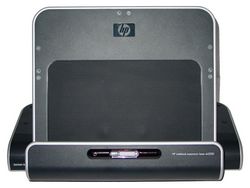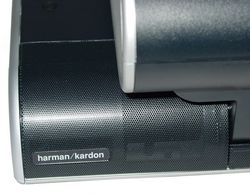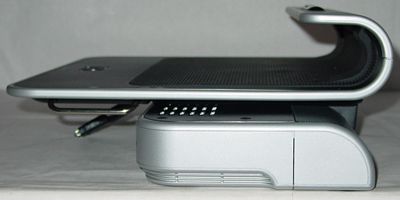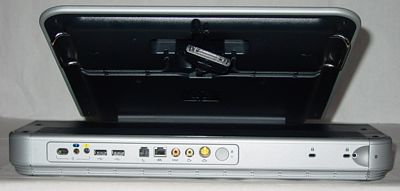HP Pavilion DV1000 Entertainment Notebook PC - Multimedia Notebook A Breed Apart
by Jason Clark on October 2, 2004 11:03 AM EST- Posted in
- Laptops
Features - Hardware
One of the interesting capabilities of the DV1000, like the ZD7000 and other notebooks from HP, is the ability to use a standing expansion bay. For the DV1000, you need the HP XB2000 notebook expansion base, which is also compatible with the ZX5000, ZV5000, Compaq Presario R3000, and V2000 series notebooks. This base retails for $299 when you purchase your notebook from HP, and also includes a wireless keyboard and mouse. Click to enlarge. |
 Click to enlarge. |
Note that all of the function buttons on the notebook will still work even when you hook it up to the expansion base (the big black connector seen on the left side of the notebook in the picture above). You can still use all the expansion bay's ports once the notebook is connected, even without the power hooked up to the bay, but the power will be drained from the notebook's battery to power the base. In this situation, the base's Harmon/Kardon's speakers will not be enabled; instead, the notebook's Harmon/Kardon speakers will pump out the audio. Only when the AC is hooked up to the base will audio be fed through the base's speakers. (Hooking up the AC to the notebook will not provide audio from the base's speakers).
Back side (left to right):
- 3 power ports for different notebook AC adapters (plug in the DV1000 laptop AC adapter into the port labeled "1")
- USB 2.0 ports
- Modem jack
- Ethernet jack
- SPDIF port
- RCA video out port
- S-video port
- power port for base's hard drive (in the picture, it is covered with a rubber cover)
- 2 Kensington lock ports
Right side:
- headphone port
- microphone port
- USB 2.0 port
For those just curious on how the audio works, if you plug in your headphones to the port on the base, the audio will be fed from the base's speakers. If you plug in your headphones to headphone port one on the notebook while the base speakers are feeding the audio through, the signal will cut out from the base's speakers. Plugging in your headphones to the second headphone port on the laptop will not do anything. In all three scenarios, the audio obviously will also be fed through the plugged in headphones.
As you can see, there is a hinged portion of the base that can align itself about 60 degrees at the most. There is a two-fold release mechanism that must be used in order to align the upper portion of the base. The two handles seen in the two pictures below need to be pulled out together (they secure independently) and then the notebook holder can be aligned to the proper degree.
Note that the notebook holder is rubber-lined with groves, which allow you to set the notebook up a ways without having to worry about it slipping down.
The expansion bay cable is hidden on the bottom side of the notebook holder and seems to be coiled by an internal wheel mechanism. There isn't a release mechanism for the cable (at least as far as we can tell), so you just have to pull it out.
The base can also accommodate a 3.5" hard drive. The hard drive cage is on the left side of the base and can be removed by unscrewing the single screw next to the left most lock port on the back of the base. It seems that the base actually converts the IDE signal to a USB 2.0 mass storage device, but power must be provided via a separate power adapter. We should note that the hard drive tray is apparently sold separately when you order the DV1000 and is sold with a 160GB hard drive pre-installed for an additional $179.99. If you don't choose the hard drive tray option, a faceplate will replace the hard drive tray's position.
The included wireless keyboard (2 x AA batteries) and mouse (2 x AA batteries) for the expansion base are nothing special. They are Logitech components and use a single USB receiver.
The reason behind this expansion base design approach is that HP is really trying to allow the user to use a laptop without the need for a desktop. Considering the size and what it offers, we recommend going after the expansion base if you have the money. It is worth it in our opinion, especially if you plan to output to a bigger monitor/projector/TV, since you get a platform for working away from the computer, the nice Harmon/Kardon speakers, and SPDIF output.
While this docking station packs in a lot of features, it is extremely difficult to lug around anywhere. Weighing in just shy of 19 pounds, this is something definitely designed to be left in a specific spot.















10 Comments
View All Comments
Biochem101 - Thursday, October 28, 2004 - link
Ohh yeah, just to add.The dv1040us machine has at the minimum the following specs:
Centrino 725 1.6GHz CPU 2mb cache
64 mb shared video memory (cry, but im dealing with it)
Those are the only differnces that stand out from the AT review model.
Biochem101 - Thursday, October 28, 2004 - link
I just picked one of these puppies up for ~1100 AR. When I was shopping, I was looking for a very portable laptop with some performnce. So far I love it. The screen seems to have a built in anti-glare film similar to the film used on my Sony Trinitron CRT. It provides adequate glare relief in most situations. I did notice the font blur and was somewhat dissappointed with that problem. But all in all, I found a compact, light and relatively powerful laptop with great battery performance. I havent done any performance tests on the machine yet (its the 1.6G version - dv1040us model), but I doubt there will be much difference between my machine and he one AT has reviewed here.imho- im glad a ran across this review, I was just looking for some info on the general performance of the chipset in the machine, not a machine specific review. KUDOS to AT for souping up their number of reviews.
Pete - Sunday, October 24, 2004 - link
BTW, the glare on this laptop was pretty harsh when I viewed it in CompUSA, although there was a very bright fluorescent light directly behind my shoulder. My eyes got tired looking at it after 15 mins, whereas the "regular" LCD on the Toshiba next to it was *very* easy to read.It's not just that the dv1000's screen was glossy, either. Cleartype fonts looked kind of blurry or oily, not nice at all. Actually, it's possible the screen was something like BGR, and Cleartype was set for RGB subpixel smoothing. I'll have to look into that, as the screen is this laptop's Achilles heel, and one too big for me to ignore.
Pete - Sunday, October 24, 2004 - link
No, but a faster video card will, and the BenQ Joybook 7000 has the same formfactor and screen with a Mobility Radeon 9700 to boot! I'm convinced that would sell like hotcakes here, and I'm not sure why either HP or BenQ haven't started selling them here. Apparently this Intel IGP scores 2.5K in 3DM2001, not even 2003--frickin' abysmal. I'm not even sure it'd be fast enough for something like Age of Mythology or Warcraft 3 at this screen's native res.Andrew, start pushing Anandtech's weight around to get a laptop with this formfactor and discrete graphics in the USA! :)
airfoil - Thursday, October 7, 2004 - link
Quote: "but for another $100 or $150, you can configure your DV1000 with a 1.7GHz Pentium-M 735 or 1.8GHz Pentium-M 745, respectfully."Respectfully? Does a faster prcoessor buy more respect?
trikster2 - Monday, October 4, 2004 - link
#3 that's really strange. 2gb just to play a DVD sounds excessive#4 Not sure who the ODM is but there is a Benq Joybean that is identicle
#3 my main reservation with this notebook is the brightview or whatever screen. The ones I've seen on sony and fujitsu's at frys have a lot of glare. I dumped my CRT for an LCD due to glare (lots of windows) would hate to be fighting glare on a glossy laptop screen too.
In comparison to a CRT, how bad is the glare on this laptop?
Thanks!
SDA - Sunday, October 3, 2004 - link
Question-- who makes this notebook? (I know it has an HP sticker, but IIRC HP don't make their own notebooks like.) I ask because I'd like to see if there are any nearly identical no-name equivalents available.AndrewKu - Saturday, October 2, 2004 - link
#2 - Windows is reading it wrong.Scarceas - Saturday, October 2, 2004 - link
The article says a 2GB partition is used for the quickplay system.The screen shot shows 204MB. 204MB seems more reasonable. Might want to update that.
CasmirRadon - Saturday, October 2, 2004 - link
Sounds great, if/when my old Presario notebook craps out on me in the next year or so this will be the kind of form-factor/functionality that I will be looking for. My friend just got a Pavillion, and I must say that it makes me jealous if only for the exceedingly convenient placement of headphone/usb ports. That is the kind of feature that many of us forget to look for when shopping for a notebook, but makes all the difference after extended use.